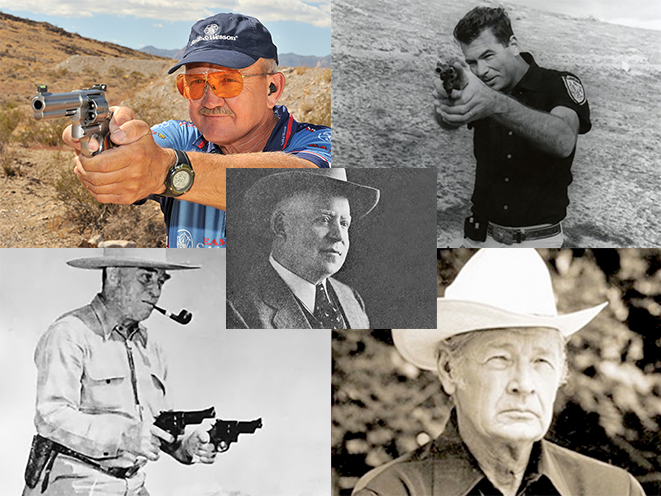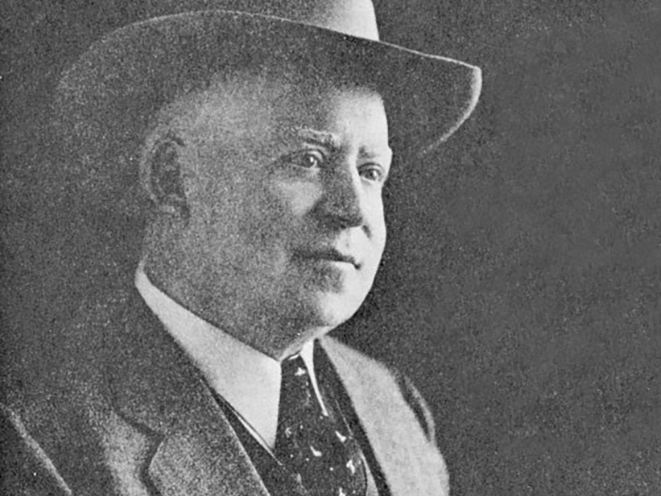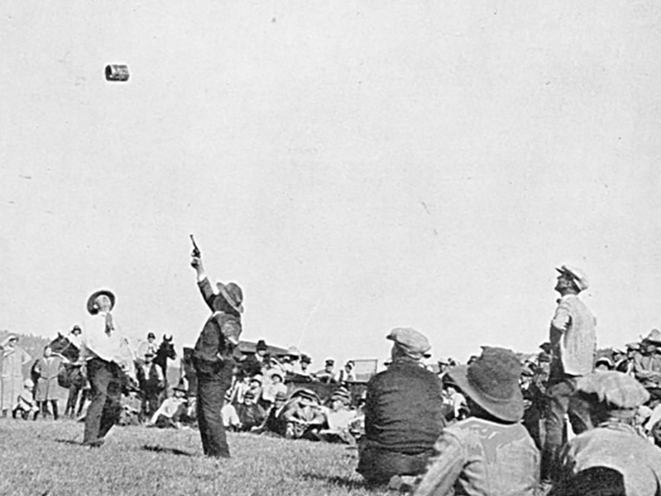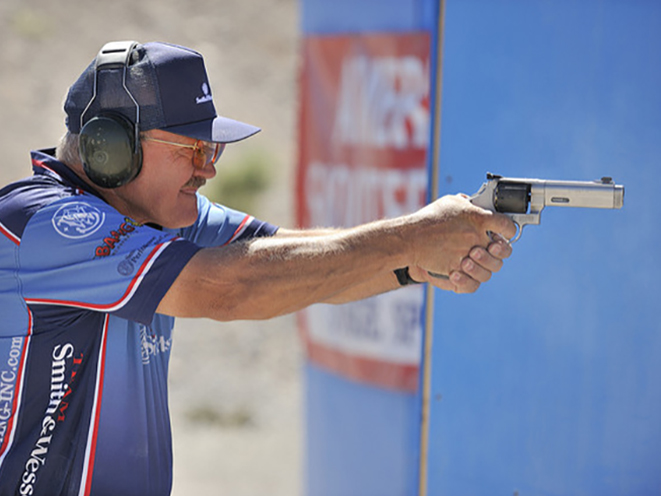Since revolvers were introduced in the late 1830s, many famous lawmen, soldiers, shootists, hunters and competitors have performed feats of marksmanship with them that have changed, improved and perfected handgun shooting. History is rife with legends of how folks such as Wyatt Earp and Bill Hickock performed prestigious feats with revolvers. But let’s focus on revolver shooters from the 20th century to the present—some famous, others less known—who have influenced the design and use of revolvers and their ammunition.
Ed McGivern
Ed McGivern was born in Omaha, Nebraska, in 1874. He was a short (only 5’5”), stocky man whose appearance earned him the nickname “Stumpy,” and he worked as a sign painter in Montana.
As a youth, he developed a fascination with firearms and uncanny skill at combining speed and accuracy with handguns. Experimentation revealed he could fire double-action revolvers faster than semi-auto pistols, and it was with revolvers he performed his most famous feats. As McGivern’s fame spread, he gave up sign painting for exhibition shooting, and he pursued that career until severe arthritis in his hands later forced him to retire.
Advertisement — Continue Reading Below
McGivern specialized in hitting aerial targets as well as hitting two targets while firing two different revolvers simultaneously. As the number of targets increased, so did his need for speed, to which he devoted most of his career.
- RELATED STORY: 8 Reasons Why Revolvers Are a Great Choice for New Shooters
According to “The Guinness Book of World Records,” McGivern’s crowning achievement occurred on September 13, 1932, when he fired five shots two times from 15 feet, and the groups could be covered by a 50-cent piece. He did that in 0.45 seconds.
McGivern could hit a dime on the fly, drive a tack or nail into wood with bullets, hit six simultaneously hand-thrown skeet targets before they hit the ground, hit a tin can hand-thrown 20 feet in the air six times before it hit the ground, and shoot the spots out of playing cards or even split a playing card edge. He was also ambidextrous and fired all of his revolvers in double-action mode.
Advertisement — Continue Reading Below
In his book “Burning Powder,” McGivern revealed his favorite revolver: “The double-action .38 S&W Special Target revolver, with a 6-inch barrel, having a gold bead front sight, is the best all-around gun to be had for this work. The McGivern gold bead front sight is…standard equipment on all my revolvers.” He did not use ergonomic target-type grips but fitted his revolvers with factory checkered walnut grips.
McGivern was also heavily involved in writing, training police officers, developing revolver sights and, with his friend Elmer Keith, revolver cartridges and long-range handgun shooting.
Jack Weaver
In the 1950s, the South West Combat Pistol League began holding “leather slap” matches near Big Bear Lake, California, in which the goal was to draw and fire accurate shots at “combat distances” during constantly changing scenarios. The father of that shooting discipline, Colonel Jeff Cooper, believed it was the best way to test what worked and what didn’t for using a handgun as a defensive weapon.
Advertisement — Continue Reading Below
Competitors used various handguns, and holsters were generally of the low-slung TV cowboy type. Most shooters used a point-shooting stance in which they fired handguns unsupported (one-handed) from waist level. Until 1959, that is.
Born in 1928, Jack Weaver was a native Californian who was fascinated with firearms from an early age. “When I was a kid, real young, I mean like about 10 or so, I was fascinated by revolvers,” he said in an “American Handgunner” article. “Not the automatic, but just the revolver. Something about the cylinder with the holes in there.”
After his military service, Weaver became a Los Angeles County deputy sheriff and a member of the department’s pistol team. He made history by becoming the first competitor to enter a combat pistol match using a two-handed hold, a system that worked so well he became the 1959 Leather Slap champion.
Advertisement — Continue Reading Below
Weaver’s choice of handgun was a .38-caliber S&W K-38 (Model 14) with a 6-inch barrel, which was the service handgun of his department and the model used by the shooting team.
Dubbed the “Weaver stance” by Cooper, Weaver’s method calls for the shooter to draw the handgun with the strong hand and bring it to waist level, toward the center of the body, as the support hand wraps around the shooting hand. The shooter’s strong arm is then extended and the support arm’s elbow is bent as he or she pushes with the strong arm and pulls with the support arm to stabilize the weapon. The shooter brings the handgun to eye level, takes a quick sight picture and fires.
The Weaver stance provided superior accuracy, recoil control and faster transitioning between targets. Soon after its introduction, all of the Leather Slap winners began using it, and the stance became an integral part of Cooper’s “modern technique” of handgun shooting. It was adopted by the FBI in 1982 and eventually became the preferred stance of American law enforcement agencies. Weaver served with the Los Angeles Sheriff’s Department until 1979, and he passed away in 2009.
Advertisement — Continue Reading Below
Elmer Keith
When the .44 Magnum is mentioned, most handgunners probably associate it with the names Smith & Wesson and Elmer Keith.
Keith (1899-1984) was the real deal: rancher, author, ballistician, reloader, firearms expert, and big-game guide and hunter. As a young man, he became fascinated with trying to improve the performance of revolver cartridges. Keith’s early work in loading the .38 Special to increasingly higher pressure levels was made possible by the availability of heavy large-frame revolvers such as the S&W .38-44 Heavy Duty and Outdoorsman. The results of his experimentation contributed to S&W introducing the .357 Magnum cartridge in 1935. He is also credited with developing the Keith-style bullet, which provided greater wounding properties and penetration.
Keith encouraged Remington to produce a powerful .44-caliber cartridge and Smith & Wesson to produce a revolver chambered for it. The resulting .44 Magnum and S&W Model 29 revolver were announced to the public on January 19, 1956. The .44 Magnum was the first handgun cartridge considered capable of taking any North American game animal and can be credited with the meteoric increase in the popularity of handgun hunting.
Advertisement — Continue Reading Below
Elmer Keith also wrote extensively about firearms, shooting, reloading and hunting, and his work was published in several of the world’s most respected firearms journals and magazines. He was a pioneer in the realm of the revolver and its capabilities. It’s unlikely we’ll see his kind again.
Bill Jordan
From the time of its introduction, the revolver was the preferred sidearm of most American law enforcement agencies. From the turn of the 20th century, the .38 Special was the regulation police revolver cartridge. But the social unrest of the 1960s and increasingly violent criminal gangs of the latter part of the 20th century led to a demand for more powerful police weapons. The answer was the .357 Magnum, but that had downsides, as these revolvers tended to be large and heavy—until a U.S. Border Patrol agent convinced Smith & Wesson that it didn’t have to be that way.
Bill Jordan was born in Louisiana in 1911 and served with the U.S. Border Patrol, mostly on the Mexican border, during some of the most violent years of the Patrol’s history. With the outbreak of World War II, he enlisted in the U.S. Marine Corps. After the war, he returned to duty with the Border Patrol until his retirement in 1965, after which became an exhibition shooter, famed author, firearms instructor and field representative for the NRA.
Advertisement — Continue Reading Below
Jordan was famed for his fast draws and accurate hip shooting. One of his most popular fast-draw demos consisted of holding a ping pong ball on the back of his gun hand, with the palm hovering 6 inches above his holstered gun butt. Then, he’d move his hand, draw his revolver and fire, and the ball would be resting inside the holster, displacing the revolver after traveling less than a foot.
A staunch fan of the double-action revolver for police work, Jordan criticized the .38 Special as lacking the power to stop a violent confrontation. At the 1954 Camp Perry matches, S&W’s president, Carl Hellstrom, asked Jordan his recommendations for the ideal law enforcement revolver. Jordan suggested a .357 built on the company’s medium K-Frame with a heavy barrel, a shrouded ejector rod, adjustable sights and target grips to improve recoil control.
The next year, Smith & Wesson introduced its .357 Magnum K-Frame Combat Magnum. Later known as the Model 19—and Model 66 in stainless steel—this revolver gave police officers the power they needed in a package compact and light enough to carry comfortably all day.
Advertisement — Continue Reading Below
Smith & Wesson Model 19/66 revolvers became the most popular American law enforcement wheelguns. I remember our local municipal police and county sheriff’s departments were so equipped until they adopted semi-autos in the late 1990s.
Jerry Miculek
If you discuss revolvers with any group of handgun aficionados, it won’t be long before someone mentions a quiet, modest Southern gentleman: Jerry Miculek.
Miculek is recognized as one of the world’s greatest shooters with every type of firearm, but it was with the wheelgun that he earned the “Mr. Revolver” title from the competition crowd.
Born in 1954, Miculek showed little interest in baseball, football and other traditional sports. Instead, he became fascinated with hunting and shooting. Trained as a millwright, Miculek did not become involved in the action shooting sports until the 1980s, and his ability with a revolver led to him becoming a professional shooter in 1989.
Since then, he has set many world shooting records with revolvers, pistols, rifles and shotguns. He’s won numerous titles with the revolver. He’s a four-time Second Chance bowling pin champion, USPSA national revolver champion, IDPA national revolver champion, IDPA world revolver champion, Steel Challenge revolver champion, international revolver champion, and overall IPSC revolver world champion and senior IPSC revolver world champion.
I’ve witnessed Miculek shooting in competition (and tried to photograph him, but he was too fast), and his speed with a double-action revolver borders on the phenomenal. His achievements include eight shots in one second; 60 shots out of 10 revolvers in 17.2 seconds; six shots, with two on each of three targets, in one second; six shots, a reload and then six more shots in 2.99 seconds; and five shots in 0.57 seconds, which is the only one of McGivern’s speed-shooting records Miculek hasn’t broken yet.
For Miculek, shooting is a family affair. His wife, Kay, and daughter, Lena, are pro shooters of note, and like Miculek, they also shoot for Team Smith & Wesson. Miculek’s skills, graciousness, modesty and sense of humor are well known and have made him a wonderful spokesman for the shooting sports. But to me, his most important contribution has been proving the revolver is not old or obsolete and, in the right hands, can hold its own against a modern semi-auto.





































